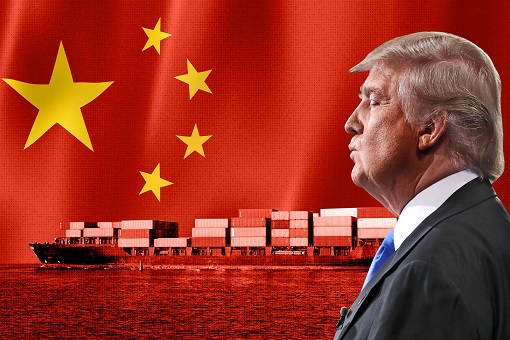
Empty Store Shelves In 2 Weeks – Here’s Why Trump’s Damage Control Is Too Little Too Late, And It Will Be Ugly
April 26th, 2025 by financetwitter
Having manufactured a tariff crisis which has backfired in his face, Donald Trump is now scrambling to manufacture a solution – without much success. Even if the U.S. president had deliberately designed the crisis with the purpose of making money through insider trading, he does not appear to have an exit strategy in the event the plan goes haywire, which is precisely what’s happening now.
Poor Trump is running around like a headless chicken, making a fool of himself and losing credibility on the international stage. While Chinese President Xi Jinping is ignoring his request to give him a call, Russian President Vladimir Putin is ignoring his request not to bomb Ukraine. Even the U.S. traditional ally – Japan – is ignoring the U.S.’ request to form a trade bloc against China.
Yes, Japan does not want to get caught up in any U.S. silly plan to maximise trade pressure on China by committing hara-kiri on its own economy in a trade war with the world’s second biggest economy. To be sure that Beijing gets the memo, Japan has conveyed to China on multiple occasions that it does not fully align with the U.S. on chip-related exports and semiconductor restrictions.

China is Japan’s largest trading partner. In fact, about 20% of Japan’s total commerce is with China, larger than its trade with the US. Trump has hit its key ally Japan with 24% tariffs on its exports to the U.S., so why should the Japanese offend its neighbour Chinese knowing very well Yakuza Trump would come back to extort more from the weak and obedient Japan.
Right now, every government is taking care of their own interest. Japanese automaker Toyota Motor Corp this week has signed an agreement worth US$2 billion to establish an electric vehicle (EV) plant in Shanghai – a strategic move to bolster its presence in China. Nissan, meanwhile, has announced plans to invest an additional US$1.4 billion in expanding its operations in China by the end of 2026.
European Union’s largest economy, Germany, is projecting another year of recession after two consecutive years of stagnation and recession. Although the U.S. government has suspended some of the “reciprocal” tariffs announced on April 2 for 90 days, the 25% tariff on German cars is still in force. Therefore, like Japan, Germany is actively ramping up investment in China.

In its effort to stop, or at least to delay, the rise of the red dragon, the U.S. believes tariff is the ultimate weapon to suppress and isolate China, the same way they had used economic isolation leading to economic stagnation and over-extension of military in the breakup of former Soviet Union. That’s why Beijing has condemned a “Cold War mentality” of the U.S. using tariff war to break up China.
But China is a different kettle of fish. Unlike the U.S.-Soviet, the U.S. and China economies are much more intertwined, not to mention the Chinese have a different economic model and did not overspend in military. Furthermore, China’s rapid development and economic prosperity makes it much harder for the Chinese people to be influenced by the Americans and Western nations.
And it is this deeply intertwined economy that Trump’s trade war with China has backfired spectacularly. The U.S. imported US$438 billion worth of goods from China in 2024. All of a sudden, most of that trade is being cut off. The 145% tariffs on Chinese goods, and the 125% tariffs on American goods are so high that it no longer makes economic sense for both countries to export to each other.

While some Chinese companies might close shop if they can’t find alternatives to U.S. market, America will face a different problem. As warned by CEOs of Walmart, Target, Home Depot and Lowe’s during a private meeting this week with Trump’s team, store shelves across America will “soon be empty“ – as early as in another two weeks.
The crazy high tariffs, made worse by conflicting statements and flip-flopping policies by the Trump administration, have seen the cancellation of 60% of shipments to the U.S. from China. Volumes of cargo scheduled to be put on ships from Asia to the North American east coast have been falling, as has the number of so-called blanked sailings – when ships skips ports at which they had been scheduled to call.
Here’re the top-10 categories of Chinese exports to the U.S.:
Consumer Electronics: US$96 billions (22% of China’s total exports)
Home Appliances: US$24 billion (19% of China’s total exports)
Textiles & Clothing: US$68 billion (17% of China’s total exports)
Optical / Medical Instruments: US$12 billion (17% of China’s total exports)
Wood / Wood Products & Paper: US$9 billion (17% of China’s total exports)
Construction / Machinery: US$33 billion (13% of China’s total exports)
Electrical Equipment (except chips): US$30 billion (13% of China’s total exports)
Clean Energy & Batteries: US$15 billion (13% of China’s total exports)
Chemicals: US$42 billion (12% of China’s total exports)
Base Metals: US$28 billion (11% of China’s total exports)

Like China or hate China, the U.S. economy literally cannot function normally without Chinese imports. Did Trump realize that China makes 80% of American toys, video game consoles, laptops and smartphones? On the contrary, China does not depend on American soybean or LNG (liquefied natural gas). Even one of its biggest purchases – Boeing aircraft – has been ordered to fly back to the U.S. after Beijing retaliated.
Americans will find out – in about two weeks – that store shelves would start to become empty, and when everyone realizes what actually happens, there could be a panic buy for the “Made-in-China” products. With ocean container bookings from China to the United States plummeted by over 60% in just three weeks since the new tariffs took effect, the worst is yet to come.
Here’s the fun part. Around April 10, about a week after Trump unveiled on April 2 an additional 34% tariff on all Chinese goods entering the U.S., the trade between both nations was essentially shut down. It takes around 30 days for containers to sail from China to Los Angeles, 45 days to Houston by sea (45 days to Chicago by train) and 55 days to New York by sea.

Meaning within 30 days from April 10 to May 10 (while the ships were sailing), people are yet to see the economic effects of Trump’s brilliant tariffs. The nightmare (like warehouse and trucking job layoff), which begins in Los Angeles, will then spread to Chicago and Houston after 2 weeks. Supposing the White House, after 3 weeks, makes the greatestU-turnto scrap all the stupid tariffs on May 31.
And let’s assume Xi Jinping is magnanimous enough to forgive Donald Trump, who would somehow manage to cook up a nice story why he is cancelling the 245% tariffs without looking like a fool, the Chinese factories would have either stopped operating or have diverted their goods elsewhere. Even if they can produce, thousands of supply chains may have been affected by disruptions of raw materials.
Let’s assume every factory in China that got screwed by American cancelled orders says “let bygones by bygones because we just love Donald Trump and USA”, and the supply chain remains undisrupted. However, based on the Covid-19 pandemic, the factories can’t restart immediately as if nothing had happened. It will be at least another 30 days before economic activity is revived.

And that’s just in Los Angeles. It will need another 45 days in Chicago or Houston. The entire disruption is like another episode of Covid-19 lockdowns. The only difference is this is caused by one person called Donald Trump (and his advisers eager to bootlick him with whatever he wants to hear). Once you shut down, it takes a long time to get the economic activity back to where it was.
If Trump does not fix the problem quickly, declining demand from U.S. importers for goods will force shipping lines to cut costs, including reducing the size of fleets, delaying building ships, cancelling orders and even scrapping some ships. By then, it would be even harder to restart the engine. It’s worth noting that China now controls 65% of global shipbuilding orderbook, controls 95% of global shipping container production and operates some 96 foreign ports globally.
Millions of Americans had voted for Trump because they were misled into believing that factory jobs, which Chinese peasants (as JD Vance likes to insult China) had taken 40 years since late 1970s to learn and master – from making plastic buckets to manufacturing iPhones and electric vehicles – tirelessly, could return to the United States with a snap of a finger.

In reality, it takes years (or a very long time in the case of the U.S.) to even construct new factories, let alone get the entire supply chain and necessary skilled workers ready. Lego, who is building a US$1 billion factory in the U.S., began looking for a location in 2021. Originally expected to start production in 2025, the plan has been postponed to 2027. That’s 6 years for Lego to make toys in America.
Despite all the tough talk about containing China and anti-Chinese rhetoric, can the U.S. wait for years until new factories are built whilst the store shelves are about to go empty in 2 weeks? Even if the Americans can wait, which they can’t, are they willing to pay US$3,500 for an iPhone or triple price for Chinese parts that are hit with tariffs, at a time when 65% of Americans were living paycheck to paycheck?
Besides more expensive, the waiting time to secure parts will be longer as they become harder to get. “From brake pads and batteries to bumpers and sensors, many of the parts used to repair and maintain vehicles are imported. If those parts are hit with tariffs, suppliers are expected to pass on the extra cost to repair shops and dealership service departments” – Cars.com editor-in-chief Jenni Newman told FOX Business recently.

And President Trump has the cheek to claim he has all the cards while his arrogant minions have claimed that they don’t need to negotiate with China, insisting that the Chinese have to make a deal with the Americans instead. The best part is Donald Trump repeatedly lies that Xi Jinping has called him, even though Beijing has announced that no negotiations, let alone phone calls, had taken place.
The next chapter of the current Yankee rednecks in Whitehouse trying to force closing China into submission to their brainless & brutal economic plan of using IMF & World Bank.
ReplyDeletehttps://youtu.be/JdQYpVWtIik?si=eZDN3ABhYClBa1_y
Bessent is forcing IMF & World Bank to rework their 1944 formation clauses under the Brettonwood Accords to subjugate China.
If these plans work, the world economy would gall into long recession & possibly leading to WWIII.